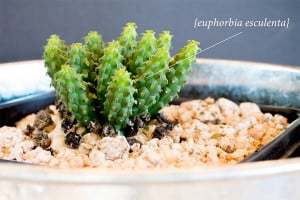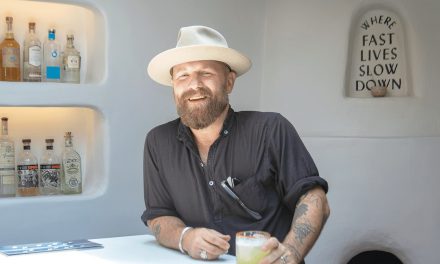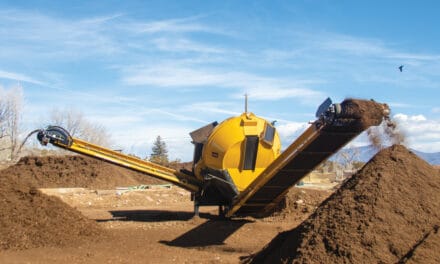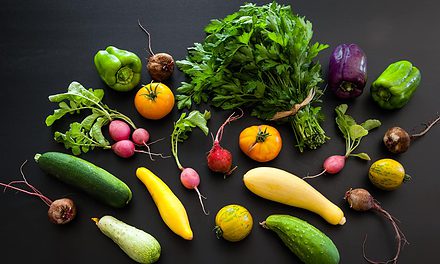Revitalizing Heritage Livestock in the Southwest
By Zach Withers

Red Wattle / Mangalitsa mix piglets at Polk’s Folly Farm, photo by Sarah Wentzel-Fisher.
What do royalty and the best lamb chop you’ve ever tasted have in common? While a joke about being “rare” would make a good guess, the point I’m after is that attempts to maintain a degree of genetic purity in a small population create some real challenges in the world of local agriculture. “Purebred” is often given a positive association in the animal world, but in reality the line between purebred and inbred is mighty thin.

Navajo-Churros from Sarah Wentzel-Fisher’s flock, photo by Sarah Wentzel-Fisher.
While there are dozens of distinct breeds of most domesticated animals, industrial agriculture has focused on just a handful that have been adapted to the intensive model of production that has dominated—and radically changed—food systems over the last century. Unfortunately, those breeds were not selected based on what tastes good or which breeds are best suited to a particular region, but rather what drives up profit or which animals will best tolerate the abuses inherent to concentrated feeding operations. What does this mean for the future of food and food production in an increasingly erratic and challenging climate? How do genetics affect the taste of that bite coming off your fork?
Let’s start with sheep. Spanish colonizers brought a breed called Churra (brush) to the Southwest in the late 1500s. The Diné (Navajo people) developed a particularly close connection to the sheep, and over several centuries the Churra adapted to the local environment, forming a beautifully symbiotic relationship to the Diné people and traditional communities across New Mexico. The sheep produce beautiful wool, a decent amount of milk, and some of the tastiest meat of any breed. They are excellent mothers, have exceptional survival instincts, do fine in both extreme cold and extreme heat, and in many ways are an ideal breed for small-scale agriculturalists to use for food and fiber production as well as regenerative grazing in the high desert. So what’s the catch?
The national sheep herd has shrunk from over fifty million to around five million animals over the last century, and heritage breeds have not been exempt from that trend. (Between the competition from chicken, beef, pork, and synthetic fabrics, the sheep industry has had a rough go.) Given that the genetic diversity that came over on boats was limited to begin with, the real challenge is maintaining and rebuilding the flock of what are now referred to as Navajo-Churros without sacrificing the traits the breed is prized for or ending up with a bunch of inbred sheep. While the Spanish brought Iberian Churra sheep to other parts of the country, the descendents of those sheep have developed and adapted to their particular localities, making them essentially different breeds. One of them, the Florida Cracker sheep, faces challenges similar to the Churro’s. Crossbreeding these two genetically similar breeds would increase the diversity of the gene pool, but it could also result in a loss of the traits that have evolved over years of selective breeding in the same area. These are precisely the traits that make the two distinct breeds desirable and important for the future of climate-adapted local agriculture.

Ideal for the New Mexico climate, Navajo-Churros have exceptional survival instincts, photo by Sarah Wentzel-Fisher.
The work of preserving Navajo-Churros is supported by organizations like the Livestock Conservancy and the Navajo-Churro Sheep Association, but mostly it is up to local producers to keep breeding the animals while tracking the genetic lines to maintain a sufficient level of diversity. Audrey Marlar in Los Lunas is one such producer. She and her husband, Richard Marlar, have been breeding Navajo-Churros for more than five years, and they keep around twenty registered ewes. They are excited to expand the herd size while also working to improve the breed by selecting for animals that meet the standards established by the breeding association. They send many of their animals back to the Navajo reservation to help rebuild the flock there, and also sell wool to artisans both on the Navajo reservation and in Chimayó. They bring in new genetics every couple of years by trading out registered rams from flocks in other states. The registration process helps track the different bloodlines and also ensures that only animals carrying the most desirable traits of the breed are being selected.
Audrey also provides stock to other aspiring sheep breeders who want to join the effort. Last year, she sold a small starter herd to Sarah Wentzel-Fisher, executive director of the Quivira Coalition, a nonprofit that works at the intersection of conservation and agriculture, supporting and advocating for adoption of regenerative grazing practices throughout the Intermountain West. Sarah lives on my farm, Polk’s Folly, in the East Mountains and grazes her sheep alongside my brother Ethan’s herd of goats as one of several integrated micro farm enterprises. She is interested in breeding this rare sheep for a number of reasons: to expand the herd, as a personal exploration into the challenges involved in starting a small livestock enterprise, and as an educational tool for teaching people about regenerative grazing practices, sheep shearing, and the process of humanely harvesting animals on the farm.

Sarah Wentzel-Fisher shearing her Navajo-Churros, photos by Francesca Oldani.

This spring, I took a drive with Sarah to the Marlars’ farm, where we learned about the process of sorting out which animals are related to which and what bloodlines Sarah might be able to use to expand her flock. The multiple genetic variables, from color (for wool production) to temperament to which animals breed easiest or grow fastest, make for dizzying calculations. The conversation drove home the importance of good recordkeeping, registering breeding stock, and, perhaps most crucially, building trust and relationships between producers.


Audrey Marlar and her Navajo-Churros in Los Lunas, photos courtesy of Audrey Marlar.
Alongside this nascent flock encountering the challenges of maintaining genetic diversity while guarding the positive characteristics of one heritage breed, another adventure in cross-pollination and adaptation is happening with heritage-breed hogs. Much like the sheep industry, the hog industry has focused on a small number of breeds that are well suited for large scale, indoor, factory production models, leaving the better adapted—and much tastier—breeds to dwindle along with the population of small farmers. At Polk’s Folly, the hogs we started with were all purebred Red Wattles, a heritage breed that was developed in Texas and is well adapted to a desert environment. We sourced our breeding stock from another farm an hour south of us that had been bringing in Red Wattles from different states to maintain genetic diversity and selecting the animals that did best in our particular climate. After a few years, we started mixing in Mangalitsas (originally bred in the Carpathian Mountains in Central Europe), both to ensure a solidly diverse gene pool and to increase the animals’ adaptability to the cold winters in their new mountain home. Now, nearly a decade into production, the question is whether to stick with Red Wattles and Mangalitsas and risk recycling genes from related bloodlines (we did not do a great job keeping records early on, so it’s hard to say if any of our pigs are related to other Red Wattles or Mangalitsas in this area) or prioritize what is sometimes called “crossbreed vigor” by mixing in even more breeds and ending up with “mountain mutt pigs.” Either way, we will continue working to keep diversity in the genetic composition of our herd while maintaining the characteristics that make the hogs well-suited to an increasingly arid mountain climate—and ensuring the meat is super tasty.

Polk’s Folly Farm piglets, photo by Sarah Wentzel-Fisher.
In the bovine world (“bovine” is the fancy word for cows), the story is similar to sheep and hogs, perhaps complicated (and concentrated) further due to the incredible Mad Men-style marketing efforts to brand one particular breed—Black Angus—as the ultimate beef-producing animal. There certainly are purebred heritage cow breeds on farms and ranches around New Mexico; Dexter cows are a popular multipurpose breed for homesteaders, and Scottish Highlanders have developed an almost cult following for their cuteness. The Weaver ranch near Portales imported and bred African Mashona cattle with Angus and Brahma bulls to produce incredibly hardy and drought-tolerant cattle lines, and some of the craziest-looking beeves I’ve ever seen! More common is the integration of some of the older Spanish bloodlines into herds that are primarily conforming to the industry-favored British bloodlines. Corriente cattle, which descend from the cows the Spanish brought over along with Churra sheep, are mostly bred and sold as sporting animals for rodeos, because they are extremely skittish, fast, athletic, and tough. (That is also why most folks raising animals for meat don’t want to deal with them.) But ranchers in the high desert are increasingly recognizing the value of the Corriente’s genetics for improving their animals’ ability to digest less palatable forage, hold body condition and conceive young during drought, travel farther to get water without suffering weight loss, fend off predators, and fatten up into a harvestable size with far fewer purchased inputs such as the protein supplements that are commonly required to fatten cattle out on the range.
(Author’s note: Corriente meat is very distinct and, to my taste, absolutely delicious, though it does tend to be leaner and tougher than Angus, especially if it’s coming off a roping circuit. But I do not recommend buying Corrientes for your first grazing animals. It’s an absolutely terrible idea. Just don’t. No matter how good a deal it might seem to be, it really isn’t.)


Emily Cornell’s cows and calf, photos courtesy of Sol Ranch.
My friend Emily Cornell, who operates Sol Ranch in northeastern New Mexico, has been bringing more Corriente genetics into her herd over the past several years. For decades, her father had used Corriente bulls to breed his first-year heifers because Corriente calves tend to be smaller and much easier for young cows to birth. The long-term impact of this practice is evident in the herd: the cows are slightly smaller and stockier than purebred British varieties of cattle and seem to be able to survive and thrive even when there is not much in the way of fresh forage. But as Emily is transitioning away from producing and selling calves and toward grass finishing and direct marketing, she is also seeing other benefits: marbling in the meat at an earlier age (which reduces the cost of producing marketable meat), increased survival instincts (Corrientes are very handy using their horns to fend off predators, or ranchers!), and feeding on a greater variety of plants on her ranch. She jokes that they will eat the bark off the cedar fence posts and not seem the worse for wear. (You can find Sol Ranch beef at tiny grocer ABQ, Polk’s Folly Farm Stand in Cedar Crest, and Semilla Natural Foods in Las Vegas, or through Reunity Resources or Squash Blossom CSA in Santa Fe.)
While the reality that most of these breeds are considered threatened or endangered is certainly worrisome, the good news is that more and more people are, first, waking up to the vital importance of preserving the breeds’ genetics and, second, returning to a type of agriculture that focuses on regional adaptability and resilience in the face of rapid climate change. Paradoxically, one of the best ways to support the revitalization of heritage-breed animals is to support the producers raising them by buying the meat and eating it. While maintaining and growing the herds and flocks of heritage breeds is vitally important work, those of us raising animals for food and fiber are also tasked with the project of remixing and matching animals in order to develop new breeds that will be adapted even better to the shifting conditions and extreme challenges facing agriculturalists of the future. And as an added bonus, the meat that comes from these animals tends to be so much richer in flavor than their industrialized commodity cousins that they bear almost no comparison.

Zach Withers
Zach Withers is a pig farmer, butcher, and cider maker from San Antonito, New Mexico. He owns and runs Polk’s Folly Farm with his brother Ethan, raising hogs, hens, sheep, and goats. They collect food waste from local businesses and feed it to their pigs, selling the meat along with other local products at their farm stand in Cedar Crest.













